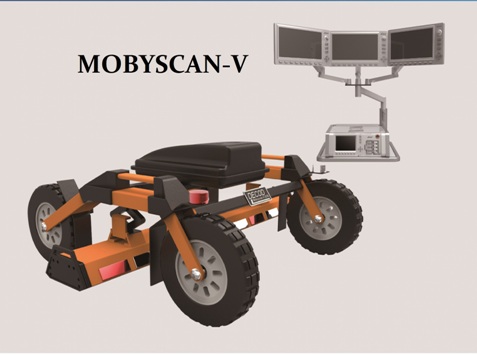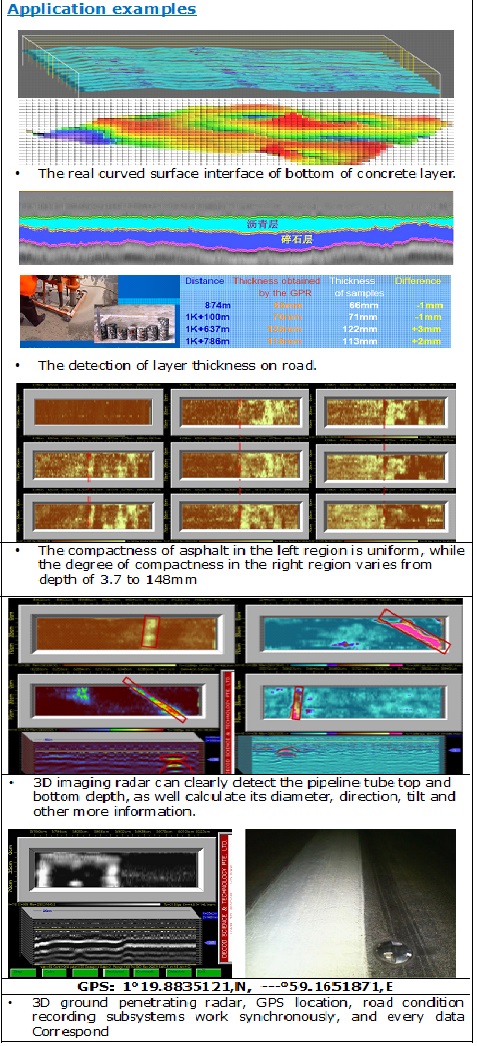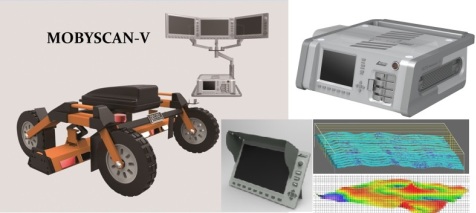

HOME > Products

- Advantages
- Data Specimen
- Config.
- Specifications
- Software
- Download Brochures
- After Sales
- Gallery
DECOD MobyScan 3D Imaging
Ultra-Wideband Radar System
An advanced system is which for transportation, infrastructure, subsurface inspection and analysis. It provides faster sample rate, uses 15.6” 1080P touch screen, new adjusted lift trailer, can connect 2000Mhz, 900Mhz, 500Mhz and other frequencies antenna arrays.
This system consists of 3D ground penetrating radar, GPS location, road condition recording subsystems. The above three subsystems work synchronously, and every data Correspond. Operator can acquire the 3D information of the road subsurface after performing one time detection. It does not require any the grid line sand multiple detections. Operating system software with a simple interface insulated from computer virus.
Main Uses
¬Я - Road structure assessment(thickness, strength & defect of subsurface layer)
¬Я - Subsurface defect detection(void, aquifers, not dense area, settlement, collapse, buried object)
¬Я - Utility designation(pipeline, cable, ditch)
¬Я - Bridge deck inspection (reinforcing bar inspection & location, damage, thickness of cover layer)
¬Я - Build 4D dynamic database detection system for runway, highway, and city road.
¬Я - Carry out a regular detection to survey changing trend of road structure.
Main features
¬Я - Low-cost, precise assessment of subsurface conditions for expressways, runways and railroads.
¬Я - Vehicle-mounted for fast and convenient deployment.
¬Я - Continuous imaging and detection at up to 100 km/h.
¬Я - Non-Destructive Detection.
¬Я - 3-dimensional, real-time subsurface imaging.
¬Я - With multiple times detection, build 4D dynamic database of subsurface information.
¬Я - 3D radar imaging on the spot, can locate, meter and assess object.
¬Я - Accurate positioning with GPS and distance-measuring wheel.
- Use lift trailer, can adjust the distance from antenna to ground surface.
Ultra-Wideband Radar System
An advanced system is which for transportation, infrastructure, subsurface inspection and analysis. It provides faster sample rate, uses 15.6” 1080P touch screen, new adjusted lift trailer, can connect 2000Mhz, 900Mhz, 500Mhz and other frequencies antenna arrays.
This system consists of 3D ground penetrating radar, GPS location, road condition recording subsystems. The above three subsystems work synchronously, and every data Correspond. Operator can acquire the 3D information of the road subsurface after performing one time detection. It does not require any the grid line sand multiple detections. Operating system software with a simple interface insulated from computer virus.
Main Uses
¬Я - Road structure assessment(thickness, strength & defect of subsurface layer)
¬Я - Subsurface defect detection(void, aquifers, not dense area, settlement, collapse, buried object)
¬Я - Utility designation(pipeline, cable, ditch)
¬Я - Bridge deck inspection (reinforcing bar inspection & location, damage, thickness of cover layer)
¬Я - Build 4D dynamic database detection system for runway, highway, and city road.
¬Я - Carry out a regular detection to survey changing trend of road structure.
Main features
¬Я - Low-cost, precise assessment of subsurface conditions for expressways, runways and railroads.
¬Я - Vehicle-mounted for fast and convenient deployment.
¬Я - Continuous imaging and detection at up to 100 km/h.
¬Я - Non-Destructive Detection.
¬Я - 3-dimensional, real-time subsurface imaging.
¬Я - With multiple times detection, build 4D dynamic database of subsurface information.
¬Я - 3D radar imaging on the spot, can locate, meter and assess object.
¬Я - Accurate positioning with GPS and distance-measuring wheel.
- Use lift trailer, can adjust the distance from antenna to ground surface.

